That Fit Friend is supported by its readers. I [Jake Boly] run this site myself and buy the gear I review. If you purchase through my site, I may earn commissions on sales, read more here!
Converse Chuck Taylor All-Star shoes have been around for decades and continue to thrive as a popular and timeless shoes. Despite not being designed for lifting, the Converse Chuck Taylor All-Star is a tried and true shoe for weight training.
For years, recreational lifters and powerlifters alike have opted for Converse Chuck Taylor All-Star to support some of their heaviest training sessions. With their stable sole constructions and durable canvas uppers, Converse can be a good shoe for lifting for multiple reasons.
As someone who started their lifting career wearing Converse and Vans, I have a deep-rooted respect for Converse in the gym but also recognize their strengths and shortcomings which I’ll discuss below.
If you want a tried and true budget-friendly shoe for general lifting, deadlifting, and casual use then the Converse Chuck Taylor All-Star can be an awesome pick. This shoe is consistent and it doesn’t break the bank for the versatility you get.
Who Should Invest In Converse Chuck Taylor All-Star?
There are a couple of populations that I think will benefit from investing in Converse Chuck Taylor All-Stars. The first is newer lifters that are looking for a good budget-friendly shoe that provides a good amount of stability.
For their price point and dual-functionality with daily wear, Converse Chuck Taylor All-Stars can be awesome options for anyone that wants a good lifting shoe without breaking the bank.
The second population is the lifter that loves training on zero drop shoes and primarily plans to use their Converse for strength and hypertrophy training. Converse delivers a flat construction which can be great for promoting stability and supporting biomechanics in exercises like deadlifts.
If you’re looking for a good shoe to lift in — and even compete in powerlifting — with a fair price point, then the Converse Chuck Taylor All-Star can be a great option to explore and look into.
Converse Chuck Taylor All-Star Pros
Over the course of my review process, training, and coaching others who enjoy Converse Chuck Taylor All-Star shoes, I’ve found multiple pros to like about these shoes.
- Tried and True Shoe for Lifting
- Stable Sole Construction With a Zero Drop
- Simplistic Construction Is Great for Daily Wear
The first aspect to like about Converse Chuck Taylor All-Star is that they’re what I would consider a “tried and true” shoe for lifting. There’s a reason powerlifters and recreational lifters have opted for these shoes for decades.
Converse are built on solid rubber soles and their insoles provide some cushion, but not enough to take away from the shoe’s overall stability. If you’re wanting these shoes for things like barbell training, machine work, and using for general training.
I’ve competed in Converse before and have squatted up to 440 lbs in them without stability issues and have used them for deadlifts over 500 lbs. In fact, these were the shoes I was wearing when I deadlifted 500 lbs for the first time. I’ve also used them for deadlifting heavier top-end sets with 545 lbs.
The second thing to like about Converse Chuck Taylor All-Star is their sole constructions, which I briefly mentioned above. Converse soles have remained relatively unchanged over the last few decades.
In general, the soles in Converse do a great job at resisting compression when training and they tend to last a while. I know some lifters who have used the same Converse for multiple years, which I think speaks to the long-durability of this shoe’s core sole construction.
Converse Chuck Taylor All-Stars are also zero drop shoes, which means that have a heel-to-toe drop of 0mm. This means that the heel and forefoot are sitting flat in these shoes versus having a heel elevation that is common in most traditional training shoes.
Zero drop or flat shoes are not necessarily always better for training and there are layers of context to discuss here. However, for movements like deadlifts and other exercises where an elevated heel isn’t desired, then this can be a positive aspect of performance, especially for those that like zero drop or flat shoes for lifting.
The last aspect to like about Converse Chuck Taylor All-Star shoes is their dual-functionality for daily wear and training. If you’re someone who just wants one pair of shoes for day-to-day wear and lifting, then Converse can be a good option to explore.
Plus, while the core construction details have remained relatively unchanged with the original Converse Chuck Taylor All-Star, you can usually find a variety of upper constructions and designs that matches your style well.
I personally always opt for neutral colors because they pair well with different outfits and I’m not bold enough to rock some of the louder or more limited upper designs that Converse has to offer.
Converse Chuck Taylor All-Star Cons
Despite there being a lot to like about Converse Chuck Taylor All-Star shoes, there are a couple of cons to note about them.
- Limited In Training Functionality
- Upper Durability Can Lack At Times
The first drawback to Converse Chuck Taylor All-Star is that they’re limited in the gym with their functionality. Two examples here would be discussing Converse performance for versatile training and for those that want a more minimalist shoe.
If you invest in Converse for weight training, then you’ll be fairly limited to using them for more static strength and hypertrophy work. These will not be the shoes for more dynamic training and for versatile training that would include jumping and running.
In regard to my point about minimalist shoes, Converse, despite having a zero drop construction, do have a bit of a stack height to them.
If you’re trying to maximize your foot contact with the floor and get as close to the ground as possible in something like a deadlift, then you’ll want to explore something like barefoot shoes.
Another drawback to Converse is that their upper constructions can rip at times when training. Note, this does not always happen, but I’ve had two pairs of Converse Chuck Taylor All-Stars rip at the boot while squatting and doing barbell lunges.
High-top models don’t generally have this issue, but it is something that can occur from time to time due to the Converse’s canvas not being able to withstand the stress of repetitive training.
Performance
To discuss the performance of the Converse Chuck Taylor All-Star, I’m going to discuss how they hold up in different training contexts including powerlifting, general training, and daily wear.
This way you can hopefully better assess if Converse are the right shoes for you at this point in your lifting career.
Testing the Converse Chuck Taylor All-Star for Powerlifting
In the context of powerlifting, the Converse Chuck Taylor All-Star is a pretty solid shoe to invest in. They’ll generally provide more than enough stability for most lifters and they can serve as a great pick for first-time competitors.
For squats, I like that it’s easy to ground the full foot in Converse and that you never run into issues with toe spring in Converse once you’ve broken them in.
The outsole in these shoe grips well and whether you’re training on wooden platforms, rubber gym floors, or carpets at meets, then you should have plenty of traction in Converse.
For deadlifts, I really enjoy Converse, and similar to squats, their stability should be plenty for most lifters. I also like the additional ankle support you get from the high-top model.
My only two nitpicks with Converse and powerlifting, which I also mentioned above, are that the stack height could a little better for deadlifts and the canvas upper can rip for some lifters.
Testing the Converse Chuck Taylor All-Star for Weight Training
For general weight training, the Converse Chuck Taylor All-Star is a good option to look into, especially for those primarily focused on strength and hypertrophy training.
In strength and hypertrophy contexts, the Converse is somewhat a “jack of all trades” and does a good job at supporting barbell training and machine work. They’re stable, grip the floor well, and look good.
I like Converse as an introductory shoe for lifting for those wanting to get more serious with their strength work and for anyone that wants to experiment with training with shoes that offer a 0mm heel-to-toe drop.
Testing the Converse Chuck Taylor All-Star for Daily Wear
On a day-to-day basis, the Converse Chuck Taylor All-Star is a pretty good shoe to explore. Since Nike acquired Converse and tweaked their insoles slightly, they do offer a bit more insole cushion compared to the original Chuck Taylor All-Star.
This increase in insole cushion has made these shoes a little easier to wear for long periods and for all-day wear. Converse can take a week or so to break in, but once you’ve broken in their soles they get even more comfortable on the feet.
Another aspect worth pointing out in this daily wear section is obviously the unrefined style of Converse. While their appearance isn’t for everyone, I do like that you know exactly what you’re getting with Converse when you invest in them.
Converse Chuck Taylor All-Star Sizing
Something that I’ve always found interesting with Converse Chuck Taylor All-Star is their sizing. Converse are shoes notorious for running large so you’ll want to ensure you get the sizing right for these before investing.
For most lifters and athletes, you’ll want to size down a half size. If you’re like me and like a snugger fit, then going down a full size can be a safe call.
With Converse, you want to get your sizing right because otherwise, you can run the risk of having them look long and clown-like.
- Converse Chuck Taylor All-Star Sizing Thoughts: Go down a half size. If you like a snugger fit, then go down a full size.
If you have additional questions on the sizing and fit of Converse Chuck Taylor All-Star shoes, drop a comment below and I can try to help you out.
Construction Details
Below I’m going to discuss some of the core construction details that can influence a Converse’s performance and durability.
- Heel-to-Toe Drop: 0mm
- Weight: 14.3 oz (for my size 10 high-top model)
- Removable Insole: No (you can take them out though)
- Canvas Upper
- Rubber Sole
- Classic All-Star Patch
- Metal Eyelets
If you have additional questions about the Converse Chuck Taylor All-Star’s construction, drop a comment below.
Frequently Asked Questions (FAQ)
Q:Are Converse good shoes for lifting?
Q:Are Converse good for squats and deadlifts?
Q:Do Converse Chuck Taylor All Star fit true to size?
Takeaway Thoughts
Converse Chuck Taylor All-Star shoes have been used for weight training for decades. Their stable soles and simplistic construction make them good shoes for lifting a variety of lifters.
I have a deep-rooted enjoyment for my Converse and they’ve served for many of my “gym firsts”, but that isn’t to say they don’t have a couple of shortcomings.
If you have additional questions about Converse Chuck Taylor All-Star shoes and if they’re a good fit for you, drop a comment below or reach out to me personally via Instagram (@jake_boly).

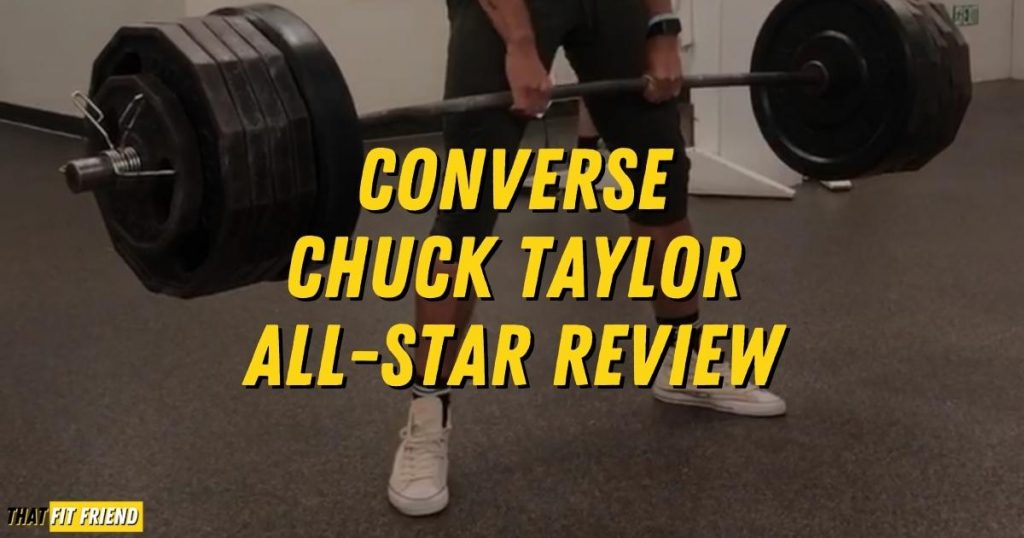
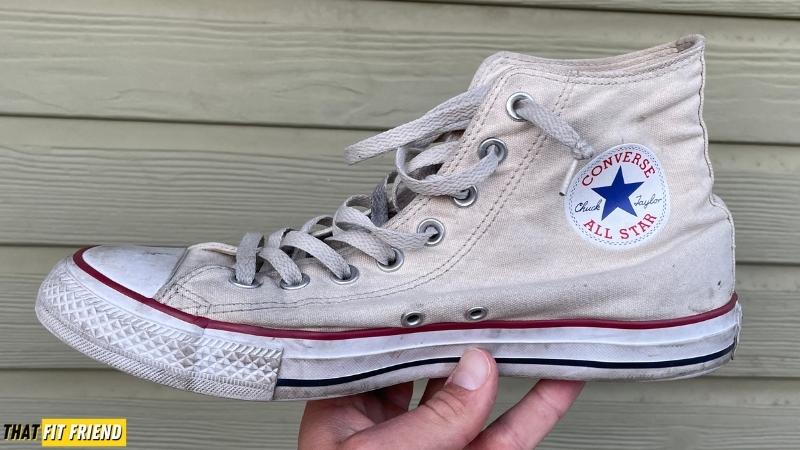






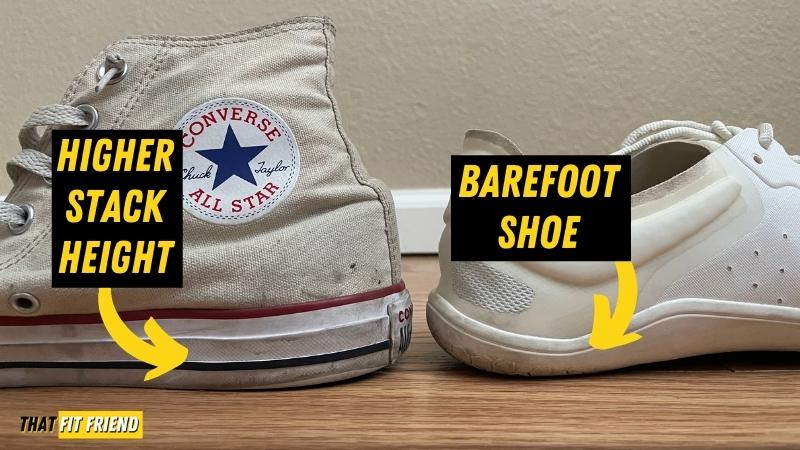








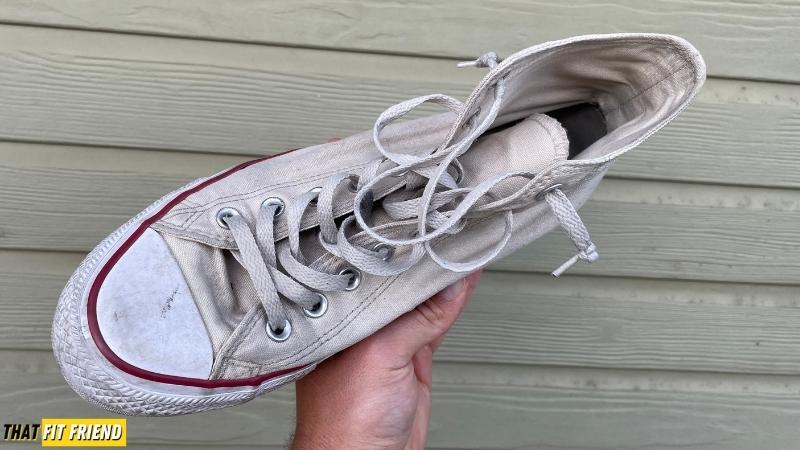

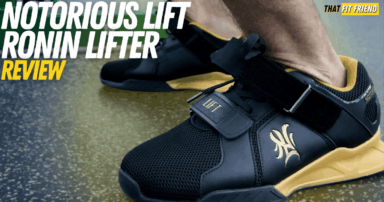



Add a Comment